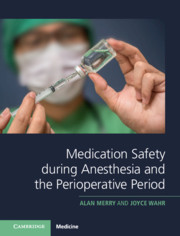Book contents
- Medication Safety during Anesthesia and the Perioperative Period
- Medication Safety during Anesthesia and the Perioperative Period
- Copyright page
- Dedication
- The Snow Vaporizer, Mark II
- Contents
- Foreword
- Acknowledgments
- 1 Introduction to Medication Safety in Anesthesia and the Perioperative Period
- 2 Failures in Medication Safety during Anesthesia and the Perioperative Period
- 3 Failures in Medication Safety in the Intensive Care Unit and Ward
- 4 Impact of Medication Errors on the Patient and Family
- 5 Consequences for the Practitioner
- 6 Why Failures Occur in the Safe Management of Medications
- 7 Errors in the Context of the Perioperative Administration of Medications
- 8 Violations and Medication Safety
- 9 Interventions to Improve Medication Safety
- 10 Medication Safety in Special Contexts
- 11 Legal and Regulatory Responses to Avoidable Adverse Medication Events, Part I: General Principles
- 12 Legal and Regulatory Responses to Avoidable Adverse Medication Events, Part II: Practical Examples
- 13 Barriers to Improving Medication Safety
- 14 Conclusions
- Index
- References
9 - Interventions to Improve Medication Safety
Published online by Cambridge University Press: 09 April 2021
- Medication Safety during Anesthesia and the Perioperative Period
- Medication Safety during Anesthesia and the Perioperative Period
- Copyright page
- Dedication
- The Snow Vaporizer, Mark II
- Contents
- Foreword
- Acknowledgments
- 1 Introduction to Medication Safety in Anesthesia and the Perioperative Period
- 2 Failures in Medication Safety during Anesthesia and the Perioperative Period
- 3 Failures in Medication Safety in the Intensive Care Unit and Ward
- 4 Impact of Medication Errors on the Patient and Family
- 5 Consequences for the Practitioner
- 6 Why Failures Occur in the Safe Management of Medications
- 7 Errors in the Context of the Perioperative Administration of Medications
- 8 Violations and Medication Safety
- 9 Interventions to Improve Medication Safety
- 10 Medication Safety in Special Contexts
- 11 Legal and Regulatory Responses to Avoidable Adverse Medication Events, Part I: General Principles
- 12 Legal and Regulatory Responses to Avoidable Adverse Medication Events, Part II: Practical Examples
- 13 Barriers to Improving Medication Safety
- 14 Conclusions
- Index
- References
Summary
There are many expert-identified recommended interventions to improve medication safety: few have been rigorously tested and proven. Adoption of electronic medication processes can and has reduced medication error on the wards and in the OR. More recently, comprehensive patient safety programs have been shown to reduce medication errorsaw well as mortality. Reduction of human error in medicine will require a comprehensive bundle of interventions rather than any single silver bullet.There are many things that most institutions and practitioners could do today: each of these may make only a small difference but the key to substantially improving safety lies in the aggregation of minimal gains. Our patients have a right to expect greater investment into medication safety by health care institutions, and greater engagement with medication safety by the clinicians who care for them. Although their time in the OR is only part of the surgical patient's perioperative journey, it is an important part. Implementation of these recommendations should be a minimum expectation for institutions and anesthesia departments today, and is an excellent foundation from which initiatives to improve medication safety can be extended to the rest of the surgical pathway.
Keywords
- Type
- Chapter
- Information
- Medication Safety during Anesthesia and the Perioperative Period , pp. 156 - 190Publisher: Cambridge University PressPrint publication year: 2021

